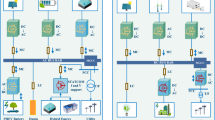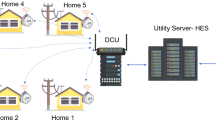Abstract
Smart contract platforms have the potential to allow shared automatic control of energy transfer within networks in a replicable, secure, verifiable and trustworthy way. Here we present a general form of smart contract which captures the elements needed for shared control that will help formalize decentralization. Two mechanisms were defined for agreement of control instructions for a medium-voltage direct-current (MVDC) link connecting two separately operated 33 kV distribution networks. These were instantiated as smart contracts and were evaluated in terms of cost and the computational requirements for their execution. Real network and converter data from the ANGLE-DC demonstration project were used to model the MVDC link. We demonstrate that using smart contracts to agree control instructions between different parties is feasible. The potential for shared control using smart contracts gives operators and regulators a way of defining and decentralizing operating responsibilities within energy systems.
This is a preview of subscription content, access via your institution
Access options
Access Nature and 54 other Nature Portfolio journals
Get Nature+, our best-value online-access subscription
$29.99 / 30 days
cancel any time
Subscribe to this journal
Receive 12 digital issues and online access to articles
$119.00 per year
only $9.92 per issue
Buy this article
- Purchase on Springer Link
- Instant access to full article PDF
Prices may be subject to local taxes which are calculated during checkout









Similar content being viewed by others
Code availability
Information about the code used in this research, including how to access it, can be found in the Cardiff University data catalogue at https://doi.org/10.17035/d.2018.0064088749.
Data availability
Information about the modelled power network cost data used in this research, including how to access it, can be found in the Cardiff University data catalogue at https://doi.org/10.17035/d.2018.0064088749. The modelled power network cost data, allowing the results to be recreated, are also provided as Supplementary Data. Underlying electricity network data is the property of Scottish Power Energy Networks and is not available via Cardiff University.
References
Liserre, M., Sauter, T. & Hung, J. Future energy systems: integrating renewable energy sources into the smart power grid through industrial electronics. IEEE Ind. Electron. Mag. 4, 18–37 (2010).
Akella, R. & McMillin, B. M. in Computer Safety, Reliability, and Security (ed. Schoitsch, E.) 263–276 (Springer, Berlin Heidelberg, 2010).
Pagani, G. A. & Aiello, M. The power grid as a complex network: a survey. Physica A 392, 2688–2700 (2013).
IEEE Standards Coordinating Committee 21 IEEE guide for monitoring, information exchange, and control of distributed resources interconnected with electric power systems. In IEEE Standards 1547.3-2007 1–160 (IEEE, 2007); https://ieeexplore.ieee.org/document/4432408
Carter, A., Marshall, B., Hamidi, V. & Osborne, M. M. The impact of new technology on network resilience. In 10th IET International Conference AC DC Power Transmission (ACDC 2012) 1–7 (IET, 2012); https://doi.org/10.1049/cp.2012.1955
Boyd, G. SPEN—DSO vision. CIRED Open Access Proc. J. 2017, 2007–2010 (2017).
Carter, S., Williamson, G., King, J., Levi, V. & Mcwilliam, J. Key findings of DS2030—a study into future GB distribution network operations. CIRED Open Access Proc. J. 2017, 2390–2393 (2017).
Role of a DSO (ofgem, 2018); https://www.ofgem.gov.uk/ofgem-publications/86255/roleofthedsoslides.pdf.
Wright, A. C. Reform of power system governance in the context of system change. IET Smart Grid 1, 19–23 (2018).
Walsh, P. M. & Cruz, J. B. Jr An example of the impact of information structure on decentralized multicriterion control problems. IEEE Trans. Autom. Control 24, 978–980 (1979).
Walport, M. Distributed Ledger Technology: Beyond Block Chain (Government Office for Science, London, 2016).
Mengelkamp, E., Notheisen, B., Beer, C., Dauer, D. & Weinhardt, C. A blockchain-based smart grid: towards sustainable local energy markets. Comput. Sci. Res. Dev. 33, 207–214 (2018).
Bracciali, A., Pintore, F. & Sala, M. WTSC18 overview. In Pre-Proc. Second Workshop on Trusted Smart Contracts 4 (International Financial Cryptography Association, 2018).
Christidis, K. & Devetsikiotis, M. Blockchains and smart contracts for the Internet of Things. IEEE Access 4, 2292–2303 (2016).
Morstyn, T., Farrell, N., Darby, S. J. & McCulloch, M. D. Using peer-to-peer energy-trading platforms to incentivize prosumers to form federated power plants. Nat. Energy 3, 94–101 (2018).
Chapron, G. The environment needs cryptogovernance. Nature 545, 403–405 (2017).
Magazzeni, D., McBurney, P. & Nash, W. Validation and verification of smart contracts: a research agenda. Computer 50, 50–57 (2017).
Peters, G. W., Panayi, E. & Chapelle, A. Trends in crypto-currencies and blockchain technologies: a monetary theory and regulation perspective. SSRN https://doi.org/10.2139/ssrn.2646618 (2015).
Al Khalil, F., Butler, T., O’Brien, L. & Ceci, M. Trust in smart contracts is a process, as well. In International Conference on Financial Cryptography and Data Security (eds Meiklejohn, S. & Sako, K.) 510–519 (Springer, Berlin Heidelberg, 2017).
Norton Rose Fulbright & R3 Can Smart Contracts be Legally Binding Contracts? An R3 and Norton Rose Fulbright White Paper (Norton Rose Fulbright LLP, 2016).
Raskin, M. The law and legality of smart contracts. Georget. Law Technol. Rev. 304, 1–37 (2017).
Cao, W., Wu, J., Jenkins, N., Wang, C. & Green, T. Benefits analysis of soft open points for electrical distribution network operation. Appl. Energy 165, 36–47 (2016).
Maza-Ortega, J. M., Gómez-Expósito, A., Barragán-Villarejo, M., Romero-Ramos, E. & Marano-Marcolini, A. Voltage source converter-based topologies to further integrate renewable energy sources in distribution systems. IET Renew. Power Gener. 6, 435–445 (2012).
King, J., Berry, J. & Murdoch, N. Steady-state modelling for the integration of a bi-directional AC–DC–AC flexible power link. CIRED Open Access Proc. J. 2017, 445–449 (2017).
Aithal, A. & Wu, J. Operation and performance of a medium-voltage DC link. CIRED Open Access Proc. J. 2017, 1355–1358 (2017).
Thomas, L. J., Burchill, A., Rogers, D. J., Guest, M. & Jenkins, N. Assessing distribution network hosting capacity with the addition of soft open points. In 5th IET International Conference on Renewable Power Generation (RPG) 2016 1–6 (IET, 2016).
Newton, C., Lang, P. & Terry, S. Field trial results of power electronics in low-voltage distribution networks. CIRED Open Access Proc. J. 2017, 184–188 (2017).
Bloemink, J. M. & Green, T. C. Benefits of distribution-level power electronics for supporting distributed generation growth. IEEE Trans. Power Deliv. 28, 911–919 (2013).
Bahrman, M. P., Johansson, J. G. & Nilsson, B. A. Voltage source converter transmission technologies: the right fit for the application. In Proc. IEEE Power Engineering Society 1840–1847 (IEEE, 2003); https://doi.org/10.1109/PES.2003.1267441
Meng, L. et al. Review on control of DC microgrids. IEEE J. Emerg. Sel. Top. Power Electron. 5, 928–948 (2017).
Bottrell, N., Lang, P. & Green, T. Algorithm for soft open points to solve thermal and voltage constraints in low-voltage distribution networks. CIRED Open Access Proc. J. 2017, 1567–1570 (2017).
Long, C., Wu, J., Thomas, L. & Jenkins, N. Optimal operation of soft open points in medium voltage electrical distribution networks with distributed generation. Appl. Energy 184, 427–437 (2016).
Ji, H. et al. An enhanced SOCP-based method for feeder load balancing using the multi-terminal soft open point in active distribution networks. Appl. Energy 208, 986–995 (2017).
CEN-CENELEC-ETSI Smart Grid Coordination Group Smart Grid Reference Architecture (European Commission, 2012).
Buterin, V. A Next-Generation Smart Contract and Decentralized Application Platform Ethereum White Paper (2014); https://github.com/ethereum/wiki/wiki/White-Paper
Wood, G. Ethereum: A Secure Decentralised Generalised Transaction Ledge r (2014); https://ethereum.github.io/yellowpaper/paper.pdf
Long, C. et al. MVDC link in a 33 kV distribution network. CIRED Open Access Proc. J. 2017, 1308–1312 (2017).
Mavrocostanti, Y. & Berry, J. Real-time, centralised voltage control in 33 and 11 kV electricity distribution networks. CIRED Open Access Proc. J. 2017, 1406–1409 (2017).
Yu, J. et al. Initial designs for ANGLE-DC project: challenges converting existing AC cable and overhead line to DC operation. CIRED Open Access Proc. J. 2017, 2374–2378 (2017).
Bryans, R. et al. Real time control of a distribution connected MVDC link (ANGLE-DC). In 13th IET International Conference on AC and Power Transmission (ACDC2017) 1–6 (IET, 2017).
Joseph, T. et al. Dynamic control of MVDC link embedded in distribution network—case study on ANGLE-DC. In 2017 IEEE Conference on Energy Internet and Energy System Integration (EI2) 1–6 (IEEE, 2017).
Oliphant, T. E. Python for scientific computing. Comput. Sci. Eng. 9, 10–20 (2007).
Pérez, F. & Granger, B. E. IPython: a system for interactive scientific computing. Comput. Sci. Eng. 9, 21–29 (2007).
Van Der Walt, S., Colbert, S. C. & Varoquaux, G. The NumPy array: a structure for efficient numerical computation. Comput. Sci. Eng. 13, 22–30 (2011).
McKinney, W. Data structures for statistical computing in Python. In Proc. 9th Python in Science Conference (eds van der Walt, S. & Millman, J.) 51–56 (SciPy.org, 2010); http://conference.scipy.org/proceedings/scipy2010/
Hunter, J. D. Matplotlib: a 2D graphics environment. Comput. Sci. Eng. 9, 90–95 (2007).
Consumer oriented metrics for the Ethereum gas market. ETH Gas Station https://www.ethgasstation.info/ (accessed 21 March 2018).
Acknowledgements
This research was conducted with the support of the EPSRC HubNet: ‘Blockchain based smart contracts for peer to peer energy trading using the GB smart metering system’ (EP/N030028/1), EPSRC ENCORE ‘Feasibility of applying Blockchain and smart contracts technology to distribution grid management in the GB power system’ (EP/N010019/1), and EPSRC Reconfigurable Distribution Networks project (EP/K036327/1). The researchers would like to acknowledge and thank the funders. The authors acknowledge and thank Scottish Power Energy Networks, who provided the data needed for this research. Finally, the authors thank K. Rucinska for her review and improvement of the Abstract.
Author information
Authors and Affiliations
Contributions
L.T. conceived the paper, wrote the code and drafted the manuscript. Y.Z. conceived the RPS rules, formally defined the negotiation rules in the Methods, and made improvements to the manuscript. C.L. performed the cost analysis of the electricity networks, wrote up the relevant part of the Methods, and made improvements to the manuscript. J.W. and N.J. made improvements to the manuscript.
Corresponding author
Ethics declarations
Competing interests
L.T. has a small number of Ether, the token used by the Ethereum platform. The remaining authors have no competing interests.
Additional information
Publisher’s note: Springer Nature remains neutral with regard to jurisdictional claims in published maps and institutional affiliations.
Supplementary information
Supplementary Data 1
The modelled power network cost data
Rights and permissions
About this article
Cite this article
Thomas, L., Zhou, Y., Long, C. et al. A general form of smart contract for decentralized energy systems management. Nat Energy 4, 140–149 (2019). https://doi.org/10.1038/s41560-018-0317-7
Received:
Accepted:
Published:
Issue Date:
DOI: https://doi.org/10.1038/s41560-018-0317-7
This article is cited by
-
Challenges in platforming and digitizing decentralized energy services
Energy Informatics (2022)
-
A blockchain consensus mechanism that uses Proof of Solution to optimize energy dispatch and trading
Nature Energy (2022)
-
Blockchain in energy systems: values, opportunities, and limitations
Frontiers in Energy (2022)



